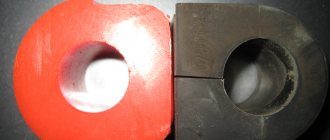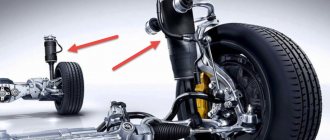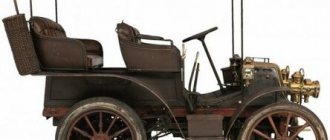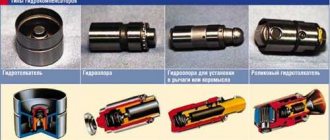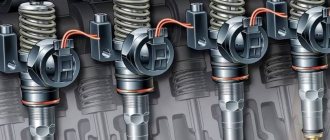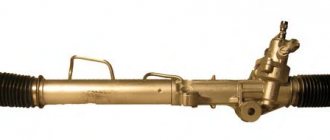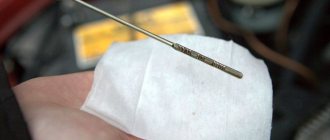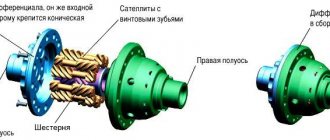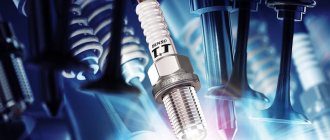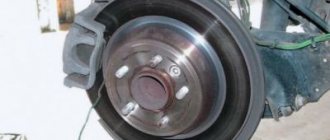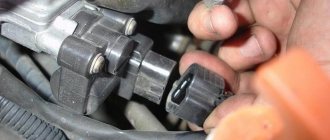What is a stabilizer bar
From the name itself it is already clear that the anti-roll bar is used to control the stability of the car at the time of maneuver or entering a turn. If you do not go into details of the structure, then such a mechanism works like a third spring on one axis. The main principle of this part is that the stiffer it is, the larger part of the load is transferred to the outer wheel from the inner one, at the moment of turning (roll moment).
The appearance of the anti-roll bar, regardless of the chosen brand or model, will be approximately the same. In appearance, it is a long round rod of an extended U-shape, bent in accordance with the racks or other suspension elements. In its structure, the mechanism is quite similar to a torsion bar, which also works to twist. Depending on its location, the mechanism can be installed on both the front and rear axles. The exception is cars that use a torsion beam on the rear suspension; a stabilizer is not installed on them due to the structure of the structure.
Everything ingenious is simple
Despite all the responsibility of the anti-roll bar, its design is outrageously simple.
In essence, it is a metal rod of complex shape that connects opposite wheels on an axle. The stabilizer is attached to the wheels (more precisely, to the suspension arms) by rods, or struts, also called links; in its middle part it is attached to the body elements using special bushings that allow it to twist like a torsion bar, preventing excessive body roll.
To a greater extent, the shape of the rod (stabilizer) in modern cars depends on the presence and position of the units located under the bottom, so it can take on the most bizarre configurations.
- Right pillar;
- Stabilizer strut (link);
- Anti-roll bar;
- Left pillar;
- Hub knuckle;
- Hub;
- Longitudinal thrust;
- Rear transverse link;
- Front transverse link;
- Stretcher.
The hero of our article, number 3, performs his work thanks to the same physics that endowed metal rods and rods with the ability to spring when twisted along an axis. These are the so-called torsion bars.
In our case, this effect works as follows. Let's assume that you have a car with independent suspension on all axles. When entering a turn at speed, inertial forces tilt the body, which is why the wheels on one side are loaded more heavily, and on the opposite side, on the contrary, they unload and try to break away from the road.
This is where the finest hour of the rear and front anti-roll bars begins. Since the different ends of the rods in this case turn in different directions, the torsion bar effect is triggered, which tries to align them, and the more the body rolls, the more they resist this.
Thus, it is possible to compensate for negative vibrations and, as a result, not to lose the necessary grip of the wheels on the road. By the way, I would like to note that these useful rods are used exclusively in independent suspensions, where each of the wheels lives its own life, and in dependent ones they are completely unnecessary, everything is fine there.
Device
A typical stabilization system in most cases consists of 4 parts:
- a round steel rod bent into a U shape;
- two rods;
fastening elements (rubberized bushings, clamps).
The rods are made of steel, mounted across the car body, and are the main elements of stabilizers. Most often, rods have complex shapes that take into account the location of other parts under the bottom.
Rods (links) are the parts by which the rods are attached to the struts of the shock absorption system (levers). Visually, these are rods of 5-20 cm, at the ends of which there are hinged joints. Their purpose is to give mobility to the nodes. The hinges are protected by anthers, which are also used for fastening to the suspension elements. Under high loads while driving, the hinge elements may collapse. They are changed every 20-30 thousand kilometers.
The stabilizers are secured to the body using 2 ball joints. Silent blocks (rubberized bushings) allow the beam to twist like a torsion bar, and clamps securely fasten it.
Steel pipe or rod
The steel pipe or also known as the rod is considered the most important part and is often called the stabilizer. In appearance, it is an elastic steel spacer, transversely located, made of special spring steel. The shape of the rod itself depends on the design of the underbody of the car and may vary depending on the suspension.
Fastenings
The shape and fastenings also depend on the make and model of the car, but for the most part they are rubber bushings and metal clamps. With the help of these parts, the steel rod is attached to the body and suspension of the car, the bushings themselves allow the mechanism to twist, and the ends are rigidly attached to the struts or suspension arms.
Stabilizer link (strut)
The stabilizer rod, or also called the strut, serves to connect the rod to the shock absorber strut or levers. In appearance, the stand resembles a rod, often from 5 to 20 centimeters long. At the ends of the rack there are hinged joints, turned in opposite directions relative to each other and protected by anthers. The hinges ensure the mobility of the mechanism, as well as a more reliable connection.
It is these rods that bear the most load, so over time, the hinge joints on the rods are destroyed and require replacement. Depending on the driving style and the design of the traction, on average it is enough for 20-30 thousand kilometers. It is not recommended to delay replacement, as the steering may fail.
Possible faults
Below are the most common SPU malfunctions.
Rack failure
One of the most common malfunctions is a broken rack. You can notice it by purely external signs, without conducting a visual inspection of the SPU. The malfunction manifests itself in the following “symptoms”.
- Deterioration in vehicle controllability. The car obeys the steering wheel worse, “yaws” when turning (and sometimes when driving straight).
- Increased roll when turning. Since the strut no longer transfers the load to the rod, the car's tilt when turning increases.
- Rocking. The car begins to rock when braking or driving on uneven surfaces.
- Skids. The vehicle may skid when turning.
- Extraneous sounds. Faulty strut joints can make audible sounds.
To find out if the rack is broken, you need to:
- turn the wheel to the limit;
- shake the part by hand.
If it plays, there is a breakdown. The rear pillars can only be checked in the inspection hole, since access to them can only be achieved with its help. If there is no inspection hole, the inspection is carried out at a car service center.
Do I need to change a loose strut? The correct answer is definitely yes. It is unacceptable to drive a car with a faulty stabilizer link. If the breakdown is not repaired in time, this can lead to an accident, since a failed SPU linkage significantly impairs the car’s handling.
Bushing abrasion
SPU body mount bushings can wear out over time. You can tell that this has happened by the knocking sound coming from the suspension. It must be remembered that knocking can also be caused by a faulty shock absorber. However, in this case, it will be heard only when overcoming unevenness, holes, and potholes. And if the bushing is broken, a knock will almost always be heard.
If the bushings are not changed in time, the body will sway sideways when driving and “yaw” when turning. All this significantly worsens handling. Therefore, it can lead to an emergency on the road.
To check whether the bushings are in order, you need to drive over a low obstacle (a regular speed bump will do). If a knocking sound is clearly heard in the pedal area, then the bushings are completely faulty and require replacement.
Bar deformation
Under regular loads of increased intensity, the SPU rod may become deformed. This manifests itself in exactly the same way as a malfunction of the racks. To make sure that a breakdown actually occurs, carry out a visual inspection of the rod. During this process, an even object is applied to the part along its entire length - this allows you to notice even the slightest curvature of the rod.
If the rod is bent, a new one must be installed. No matter how much a driver drives with a faulty part, sooner or later it will lead to an accident.
What types of stabilizers are there?
Having figured out what an anti-roll bar roughly looks like and its main functions, let’s consider the type of mechanisms, what is the difference between the front and rear stabilizers, and what the stiffness depends on.
The first thing you should pay attention to is its location, on the front or rear axle. Depending on the axis, the shape of the stabilizer, bushings for fastening and rigidity will change accordingly. Another nuance of the suspension structure is that on some passenger cars a steel strut is not installed at the rear, but it must be on the front axle.
One of the varieties is considered to be an active anti-roll bar. The main distinguishing characteristic of the active mechanism is the ability to control rigidity depending on the road, as well as the nature of the vehicle’s movement (sharp maneuvers, frequent turns, etc.). The maximum torsional rigidity will be at the moment of entering a sharp turn; medium rigidity can be observed on a dirt road or with poor surfaces. If you drive off-road, the system completely turns off the active stabilizer to avoid damage.
The stiffness in the active anti-roll bar is adjusted in several ways. The main one is through the use of an active drive. The second option is through the use of hydraulic cylinders (instead of conventional racks or instead of bushings). If the system is built on the basis of hydraulics, then the hydraulic drive is responsible for its rigidity. The design of the hydraulic drive itself largely depends on the hydraulic system installed on the vehicle.
The principle of operation of the anti-roll bar and its implementation
An anti-roll bar is a round metal bar, which is sometimes given a rather bizarre shape, through a special lever and a strut (depending on the make of the car) connecting the car’s suspension elements. The principle underlying its operation can be better understood with the help of the given figure.
Let's look at why it is needed and how the front anti-roll bar works. When a car moves in a turn, the resulting centripetal force presses the wheel moving along the outer radius to the road surface, while the inner one, on the contrary, tries to tear it away from it. Since the suspension elements are connected to each other through a lever by the anti-roll bar, highlighted in red, and its middle is fixed motionless, when one end goes down and the other goes up, it works like a torsion bar.
Part of the force generated on the wheel located on the outer side is transferred to the inner one, thereby equalizing the load between them.
Why is it needed?
When cornering, a centripetal force acts on the car, directed from the center. Under its influence, the car begins to roll, the load on the outer wheels increases, and on the inner wheels decreases. Accordingly, the grip of the wheels on the road decreases and controllability deteriorates.
This is especially true for cars with independent suspension. Just to compensate for the deterioration:
- controllability;
- wheel traction with the road;
- conditions for safe movement
An element such as Anti-Roll bars is introduced into the design of the car. Its design may differ for different models and brands of cars; it uses different struts, a lever and bushings for the anti-roll bar.
How Anti-Roll bars work under different conditions
Despite all the external attractiveness of such a technical solution, in many cases doubts arise about the need for its use. This can best be understood through the example of SUVs. As a rule, their rear axle has a dependent suspension, in this case, the anti-roll bar of the rear suspension is no longer needed; the rear axle itself performs its role perfectly.
This approach allows us to understand the limitation associated with the use of a stabilizer. A characteristic feature of independent suspension is that each wheel independently adapts to the road terrain, while one does not in any way affect the operation of the other. If we install a front stabilizer, then the suspension ceases to be completely independent, and part of the effort from one wheel begins to be perceived by the other.
The design of such an element on different cars can be made differently, but the characteristic feature that describes its operation is rigidity. A stiffer anti-roll bar, especially the front one, deprives the independent suspension of its inherent advantages, and the rear anti-roll bar affects the stability of the car when passing a winding road and understeer.
Thus, the main contradiction arises, characteristic of a classic stabilizer - it improves the car’s behavior when cornering, and at the same time worsens the characteristics of the independent suspension, which affects the car’s handling. In addition, the behavior of the machine depends on the rigidity of such a structural element.
On the other hand, a deterioration in the cross-country ability of SUVs in off-road conditions was noted, because It becomes possible for the wheel to hang out due to a decrease in suspension travel. So the question arises, why is it needed when driving in such conditions when it is designed to work only at high speeds in corners?
How to choose racks
One of the main parameters of stabilizer struts is their size. It is necessary to select new rods so that the dimensions completely match. Otherwise, this may lead to unpredictable consequences during the operation of the car.
But even knowing the required size, the choice of rods remains extremely large. Original spare parts sometimes have a very high cost and are usually designed for operating conditions different from those around us (for example, if you are the owner of a European foreign car, then it is obvious that the service life promised by the manufacturer is designed for travel on smooth European roads, and not on ours domestic off-road). Therefore, people often resort to buying analogues.
When purchasing analogues, we advise you to pay attention to the country of origin. Often on parts, information about the country of packaging is larger than information about the country of manufacture. This may confuse the buyer.
The most common offers on the market are from the following reputable manufacturing companies: LEMFORDER (Germany), TOPRUN (Germany-China), STR (South Korea), Links Master (Russia).
Options for resolving contradictions
The most radical way to get rid of such contradictions is the so-called adaptive suspension, in which the stabilizer is no longer needed. In this case, the principle of controlling the position of the body during movement is used, which makes it possible to eliminate its roll when performing various maneuvers.
Another approach, not so drastic, is to use a hydraulic cylinder instead of a stabilizer bar link. Under normal conditions, when the hydraulic cylinder is locked, the stabilizer operates as usual. In off-road driving conditions, when it is not needed, the hydraulic cylinder is unlocked from the instrument panel and the stabilizer is turned off.
It can operate in automatic mode, but for this, a lateral acceleration sensor, a hydraulic pump and hydraulic cylinders, and a control unit are used. A hydraulic cylinder is also used instead of a rack. When the car is moving in a straight line, the hydraulic pump is turned off and the stabilizer operates as usual. If lateral accelerations occur, the pump turns on and changes the pressure in the hydraulic cylinders. Depending on the driving conditions, the pressure can be different, which ensures adjustable stiffness of the stabilizer.
However, the hydraulic cylinder can be attached not to the lever and stand, but directly to the body, as is implemented in some Toyota vehicles. Depending on the driving conditions, the stabilizer is either locked or unlocked.
Such a design element of a car as Anti-Roll bars is somewhat ambiguous in nature. On the one hand, it is necessary when the car is moving at high speed in turns, on the other hand, it worsens the characteristics of the independent suspension, giving it features inherent in the dependent one. In order to avoid such a contradiction, it is necessary to use special design solutions.
Replacement and repair of SPU - when is it required and how is it done?
Repair of the stabilizer must be carried out immediately in cases where its elements are clearly deformed. If you see that the bar has bent slightly, it is recommended to carefully align it. But in case of significant deformations, the solution is to immediately replace it.
In addition, repair or replacement of the SPU is carried out when the mechanism cushions lose elasticity (severe wear) and their fit to the rack is poor. In order to repair or install new pillows, you need to perform the following steps: unscrew the mounting bolts from the bracket that holds the pillows; Slide a screwdriver under the bracket, carefully pry it up and remove it.
After this, you can remove the pillow (the right one should be moved outside the machine for dismantling, the left one should be moved towards the center) and repair it or install a new one. Removing and replacing SPU racks also does not require too much time. The process is carried out using keys “14” according to the following scheme:
- unscrew the nut on the rod that holds the fastening bolt;
- take out the bushing (upper);
- move the strut bolt from the suspension arm (direction down), after which two more bushings are dismantled - a rubber bushing and a special spacer bushing.
Using the same principle, the second rack is removed, replaced or repaired, and then installed in the reverse order. If you need to dismantle the bar, after removing the racks you will need to remove the cushion brackets (we described this operation earlier), after which the bar can easily leave its location.
Advantages and disadvantages of stabilizer
Based on the described situations and purpose, the anti-roll bar significantly affects the handling, suspension stiffness, and to some extent the vehicle’s cross-country ability. In the absence of this part in the suspension, the car would poorly withstand overloads at the time of maneuver or entering a turn, and controllability would be reduced to almost zero.
In addition to the positive properties, there are also negative aspects. This is especially true for SUVs. The very design and method of attaching the stabilizer reduces the suspension travel, which negatively affects the off-road patency of SUVs. A wheel that cannot fall lower than allowed by the mechanism simply hangs in the air, which leads to loss of contact with the road surface. Most often, in such a situation, the car may get stuck and the driver will have to look for a way out.
